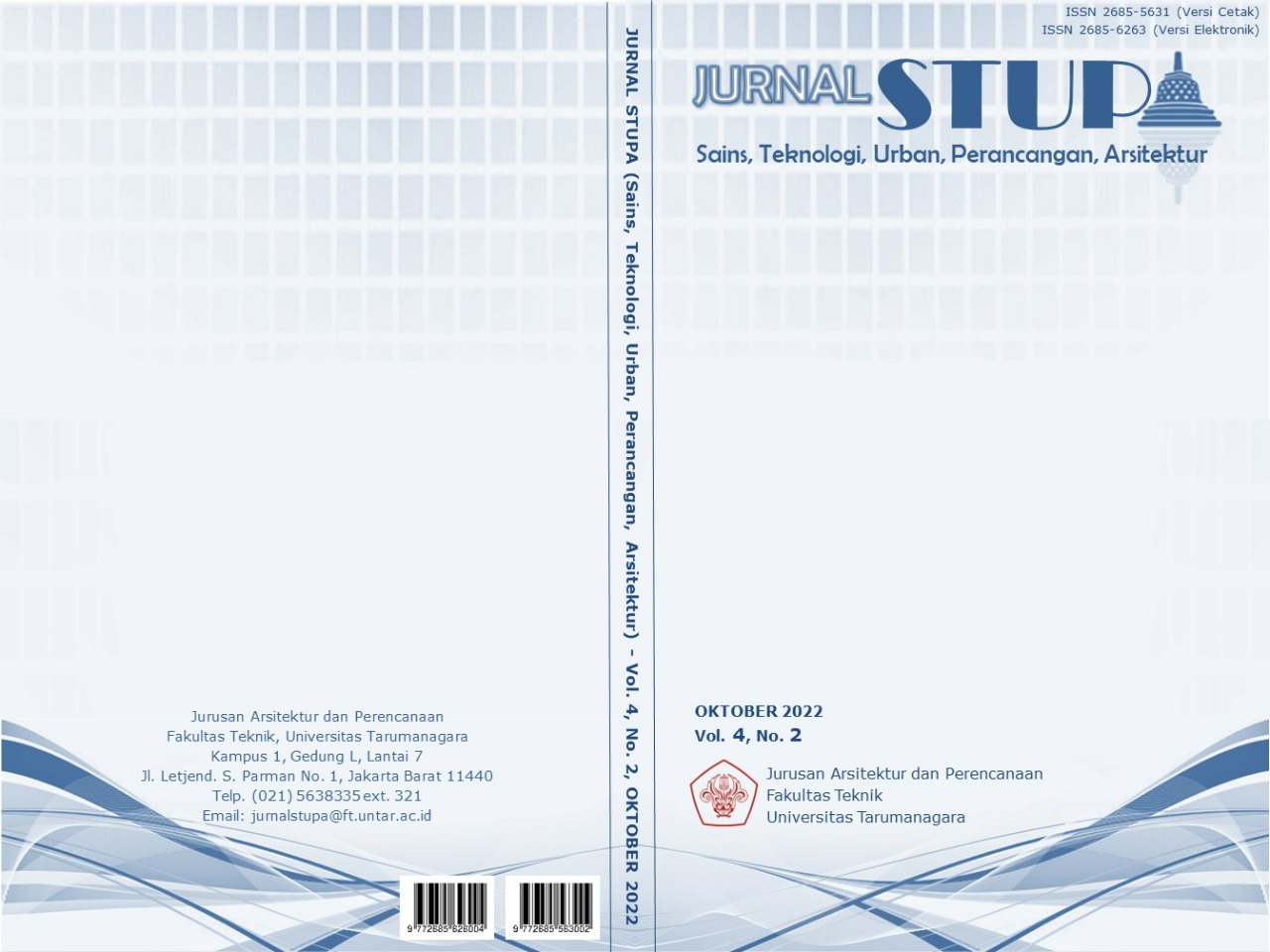OMNICHANNEL RETAILING PADA PERANCANGAN PUSAT HIBURAN BARU DI PAMULANG, TANGERANG SELATAN
Main Article Content
Abstract
Continuous infrastructure and economic development cause land values in satellite cities to increase. This encourages stakeholders to re-examine whether the function of buildings on these potential lands is still relevant or has been abandoned. The same case occurred in the Pamulang Square area, Pamulang, South Tangerang. In the past, the trade center was successful and gained popularity among developers. However, now its prestige is fading after the shifting trend of retail consumers. Seeing this area that is almost dead makes this area suitable as a target for urban acupuncture. The idea is how to create a new 'shopping center' that could revive this area while providing benefits to all parties.The design process begins by finding out the history and development of shopping centers from time to time. The design method used is narrative architecture, where the project will describe the transition from a trade center to an entertainment center. In addition, film and collage methods are used to unite two contrasting entities. The result is an entertainment center that prioritizes the visitor experience to increase traffic to this area. The narrative in this project starts from the form of an adapted trade center to apply the latest technology, which is then continued with an outdoor gathering area with food and beverage stalls, as well as a retail area combined with interactive activities. Using an omnichannel retailing concept that combines technology and brick-mortar provides a new experience in response to a decline in shopping trips. It is hoped that by adopting these ideas, the area around Pamulang Square can revive and continue to provide benefits for traders and visitors.
Keywords: Narattion; Omnichannel; Retail; Trade Center; Urban Acupuncture
Abstrak
Pembangunan infrastruktur dan ekonomi yang lebih merata menyebabkan nilai lahan di kota satelit menjadi meningkat. Hal ini mendorong para pemegang kepentingan untuk melihat kembali, apakah fungsi bangunan di lahan-lahan potensial ini masih relevan atau sudah ditinggalkan. Kasus yang sama terjadi pada area Pamulang Square, Pamulang, Tangerang Selatan. Jika dahulu trade center berjaya, namun kini pamornya semakin meredup seiring bergesernya tren konsumen ritel. Melihat area ini yang sudah hampir mati, menjadikan area ini cocok menjadi target akupunktur kota. Gagasan yang disampaikan adalah bagaimana menciptakan ‘shopping center’ baru yang mampu menghidupkan kembali area ini sekaligus memberikan keuntungan kepada semua pihak. Perancangan dimulai dengan mencari tahu sejarah dan perkembangan pusat perbelanjaan dari masa ke masa. Metode perancangan yang digunakan adalah narasi, dimana proyek akan menjelaskan transisi dari trade center konvensional, menjadi sebuah entertainment center. Selain itu juga dengan metode film dan kolase untuk menyatukan 2 entitas yang kontras. Hasil yang didapatkan adalah pusat hiburan yang mengutamakan pengalaman pengunjung untuk meningkatkan arus ke area ini. Narasi dalam proyek ini dimulai dari bentuk trade center yang disesuaikan dengan menerapkan teknologi terbaru, yang kemudian dilanjutkan dengan area berkumpul outdoor dengan kios-kios makanan dan minuman, serta terdapat area ritel yang digabungkan dengan kegiatan-kegiatan interaktif. Menggunakan konsep omnichannel retailing yang menggabungkan antara teknologi dengan toko offline sehingga memberikan pengalaman maksimal sebagai respon atas menurunnya aktivitas berbelanja. Diharapkan dengan mengadopsi usulan-usulan tersebut, area sekitar Pamulang Square dapat hidup kembali dan tetap memberikan manfaat bagi pedagang maupun pengunjung.
Article Details

This work is licensed under a Creative Commons Attribution-NonCommercial-ShareAlike 4.0 International License.
This work is licensed under a Jurnal Sains, Teknologi, Urban, Perancangan, Arsitektur/ STUPA Creative Commons Attribution-NonCommercial-ShareAlike 4.0 International LicenseReferences
Bachdar, S. (2016). Seberapa Besar Potensi Q-Big, Ritel Terbesar Sinarmas?. Diakses pada 10 Februari 2022 dari https://www.marketeers.com/seberapa-besar-potensi-q-big-ritel-terbesar-sinarmas.
Bell, D. R., Gallino, S., Moreno, A. (2017). Offline Showrooms in Omnichannel Retail: Demand and Operational Benefits. Management Science, 64(4), 1-23. Diakses pada 31 Maret 2022.
Casagrande, M. (2014, November). Paracity: Urban Acupuncture. dipresentaskan dalam seminar International Conference Public Space Bratislava, Bratislava, Slovakia. Diakses pada 09 September 2021.
Cruz, E., et al. (2019). An Augmented Reality Application for Improving Shpping Experience in Large Retail Stores. Virtual Reality, 23, 281-291. Diakses pada 12 April 2022.
Hsia, T-L., Wu, J-H., Xu, X., Li, Q., Peng, L., Robinson, S. (2020). Omnichannel Retailing: The Role of Situational Involvement in Facilitating Consumer Experience. Information & Management, 57(8), 1-14. Diakses pada 30 Maret 2022.
Lerner, J. (2014). Urban Acupuncture. Washington, DC: Island Press, 2014. Diakses pada 09 September 2021
Parcitypatory. (2021). Can Urban Acupuncture Really Heal Cities?. Diakses pada 10 Februari 2022 dari https://parcitypatory.org/2021/01/12/urban-acupuncture.
Ram, S. (2017), Meeting millennials where they shop: Shaping the future of shopping malls. Diakses pada 10 Februari 2022 dari https://www.mckinsey.com/industries/real-estate/our-insights/meeting-millennials-where-they-shop-shaping-the-future-of-shopping-malls.
Rigby, D. K. (2011). The Future of Shopping. Harvard Business Review, 259(16), 1-18. Diakses pada 10 Februari 2022.
Roozen, I., Katidis, P. I. (2019). The Importance of the Service and Shopping Customer Experience in a Retail Environment. Journal of Relationship Marketing, 18(4), 247-279. Diakses pada 31 Maret 2022.
Sanburn, J. (2017). Why the Death of Malls is About More Than Shopping. Diakses pada 10 Februari 2022 dari https://time.com/4865957/death-and-life-shopping-mall.
Sutanto, A. (2020). Peta Metode Desain [Electronic version]. Jakarta: Universitas Tarumanagara. Diakses pada 10 Februari 2022.
von Briel, F. (2018). The Future of Omnichannel Retail: a Four-stage Delphi Study. Technological Forecasting & Social Change, 132, 217-229. Diakses pada 30 Maret 2022.
Wenzel, S, Benkenstein, M. (2018). Together Always Better? The Impact of Shopping Companions and Shopping Motivation on Adolescents’ Shopping Experience. Journal of Retailling and Consumer Services, 44, 118-126. Diakses pada 12 April 2022.



